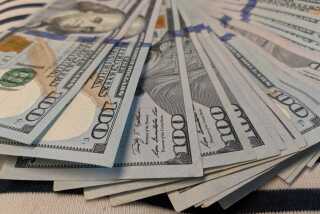Predicting the Course of the Dollar
- Share via
The clamor over the dollar’s strengthening in recent weeks, and central banks’ efforts to change its direction, prompts one to ask just how exchange rates are determined. Central bank intervention is nothing new, of course. Since the agreement reached at New York’s Plaza Hotel in 1985, the U.S. Federal Reserve Bank and the West German and Japanese central banks have intervened heavily in foreign exchange markets. But it is not at all clear that they’ve had much effect.
As a recent paper by the National Bureau for Economic Research points out: “Successful intervention does not really work independently of fiscal and monetary policy. . . . Intervention is effective only when markets interpret the action as a credible signal of government intentions.”
So after the Plaza accord, although intervention has been given credit for the dollar’s fall, it seems much more likely that intervention was able to work because the Fed’s monetary policy made it clear that it would let interest rates fall despite rapid growth of the money supply.
When not accompanied by reinforcing monetary policies, intervention has frequently failed. In 1988, the dollar rose despite large-scale efforts by U.S., West German and Japanese central banks to hold it down. Now, central bank intervention also seems to be failing, not least because major industrial countries have failed to send a clear message of their resolve to depress the dollar.
If central bank manipulation is not the key to exchange rates, what is? Certainly not the purchasing power parities theory, which purports to determine the “true” exchange rate for the dollar. The PPP theory starts with the assumption that goods and services should cost the same in all countries when measured in a common currency, and it sets the PPP exchange rate as the rate that equates prices in two countries. But in Japan, for example, consumer preferences for domestic products and a complex distribution system make a mockery of the idea of trade flows equalizing prices.
Another school of thought holds that exchange rates will move to eliminate, or at least reduce to a sustainable level, disequilibria in trade balances between countries. According to this theory, the United States’ continuing trade deficit--likely to exceed $100 billion again this year--should now be causing the dollar to fall. In fact, the dollar has firmed.
One reason that the trade balancing theory fails is that the dollar is far and away the world’s premier reserve currency, accounting for some 70% of the world’s foreign exchange reserves. This reserve role creates a demand for dollars not only to spend, but for central banks to hold. In times of crisis--such as the current political upheaval in China--this demand is reinforced by private investors, who view the dollar as a safe haven in an uncertain world.
If central bank intervention doesn’t work and the purchasing power parity and trade equilibrium theories fail to shed much light on exchange rate movements, what does? My research shows that the spreads between real--or inflation-adjusted--interest rates in the major industrial countries explain much of the dollar’s performance in the 1980s. Changes in the value of the dollar against the West German mark, for example, lag behind changes in the spread between West German and U.S. bond rates by three to nine months, thereby providing a good tool for predicting short-term movements of the dollar.
Real bond spreads display a better correlation with the dollar’s strength than do real spreads in short-term interest rates, for good reasons. As the vehicle that central banks use to control the domestic economy, short rates tend to be more volatile than long rates. Because of this, foreign exchange markets may not fully take into account some of the wilder swings in short rates if, for example, they expect these swings to be pretty quickly reversed. Bond rates tend to be less volatile and, with their longer maturities, bear a greater exposure to exchange rate risk.
The correlation between real interest rate spreads and the strength or weakness of the dollar has been much better in the 1980s than it was previously. The main reason for this is that trade-related currency flows are accounting for an ever-smaller share of total currency flows. The Eurodollar market, for example--consisting of dollar-denominated assets at banks outside the United States--has grown from a modest $10 billion or so in 1964 to well over $2 trillion in 1988. Movements in this market can outweigh even the effects of annual trade deficits in excess of $100 billion.
The huge outpouring of dollars onto world financial markets--a net outflow of almost $700 billion between 1983 and 1988--created by the United States’ massive current account deficits, helps explain the dollar’s interest sensitivity. When the real interest rate spread moves against the dollar, foreign investors, seeing their returns threatened, pull out, forcing the dollar down.
The lag of one to three quarters between changes in real bond spreads and the resulting exchange rate movements gives us a useful predictive tool in the short term--if the spread between U.S. real bond rates and Japanese bond rates rises, for example, we can expect the dollar to strengthen against the yen within three to nine months.
Beyond that, it provides no firm guide to the movement of the dollar beyond the next few quarters. But then if I had discovered an ironclad predictor of the dollar’s value, I would probably now be ensconced on some tropical island paradise acting on my analysis rather than writing about it.
More to Read
Inside the business of entertainment
The Wide Shot brings you news, analysis and insights on everything from streaming wars to production — and what it all means for the future.
You may occasionally receive promotional content from the Los Angeles Times.










